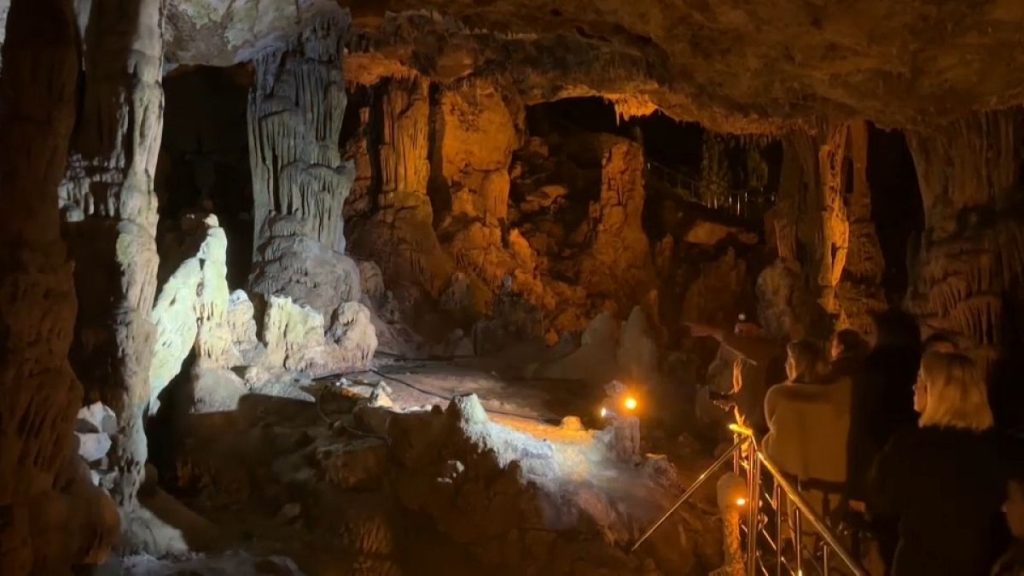Ballıca Cave, a breathtaking natural wonder nestled in the northern Anatolian province of Tokat, Turkey, stands as a testament to the Earth’s geological artistry and a sanctuary for those seeking respite from respiratory ailments. This remarkable cave, currently gracing UNESCO’s World Heritage Tentative List, welcomed an impressive 90,000 visitors in 2024, drawn by its stunning formations, intriguing history, and purported therapeutic qualities. Its allure stems from a combination of factors: the mesmerizing beauty of its stalactites and stalagmites, the unique microclimate within its chambers, and the air of mystery surrounding its unexplored depths. While portions of the cave remain hidden, awaiting future discovery, the accessible areas offer a captivating glimpse into a world sculpted over millions of years.
The cave’s formation, estimated to have commenced approximately 3.4 million years ago, is a testament to the slow but relentless power of natural processes. Composed of karstic crystal limestone, Ballıca Cave boasts an intricate tapestry of stalactites and stalagmites, formed by the gradual deposition of minerals carried by dripping water over eons. These formations create a surreal landscape within the cave, captivating visitors with their diverse shapes, sizes, and textures. From delicate, needle-like structures to massive, imposing columns, the stalactites and stalagmites showcase nature’s artistic prowess, each formation a unique work of art sculpted over geological time scales.
Beyond its visual splendor, Ballıca Cave offers a unique microclimate that has attracted attention for its potential health benefits. Maintaining a consistent temperature of 18 degrees Celsius and a humidity level of 54%, the cave provides a stable and comfortable environment. Furthermore, the air within the cave is notably rich in oxygen, a characteristic that has drawn individuals suffering from respiratory conditions like asthma and COPD. The elevated oxygen levels and the stable temperature and humidity are believed to facilitate easier breathing, offering a potential source of relief for those struggling with respiratory challenges. This therapeutic aspect adds another layer to the cave’s significance, transforming it from a mere natural wonder into a potential haven for healing.
The scientific exploration of Ballıca Cave began in the 1980s, marking the start of a systematic effort to understand its geological history, ecological characteristics, and potential benefits. Subsequent studies in the 1990s further delved into the cave’s intricate network of wells, vaults, and pits, revealing its complex structure and providing valuable insights into its formation and evolution. Despite these ongoing investigations, much of the cave remains unexplored, adding an element of mystery to its allure. Unexplored passages and hidden chambers beckon future researchers, promising new discoveries and a deeper understanding of this subterranean realm.
The combination of natural beauty, potential health benefits, and ongoing scientific research makes Ballıca Cave a site of significant interest. Its growing popularity as a tourist destination reflects a broader recognition of its unique qualities. As visitor numbers continue to rise, so too does the importance of responsible tourism practices. Preserving the delicate ecosystem within the cave and ensuring its long-term sustainability are crucial for future generations to enjoy this remarkable natural wonder. Balancing the benefits of tourism with the need for conservation will be essential to protect the cave’s unique attributes.
Ballıca Cave stands as a compelling example of the intricate interplay between geological processes, ecological dynamics, and human interaction. Its stunning formations, unique microclimate, and potential health benefits make it a valuable resource, deserving of recognition and protection. As scientific exploration continues to unveil its secrets and as visitor numbers continue to grow, Ballıca Cave will undoubtedly remain a captivating destination, drawing those seeking both natural beauty and potential respite from respiratory ailments. The cave’s future hinges on a balanced approach that embraces both its scientific and tourism potential while prioritizing its long-term conservation.

